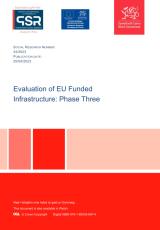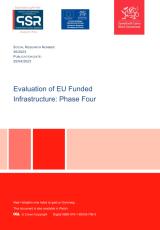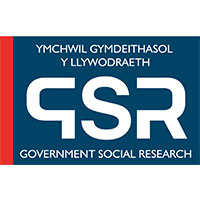Report to investigate the usage and maintenance of the new and improved infrastructure.
This is the latest release
How has EU funding been used to invest in infrastructure?
In total it is estimated that just over £800m of EU funding has been invested in infrastructure in Wales over the two programmes, on projects with a total value of £1.8bn. This includes:
- £299m in transport infrastructure
- £142m in sites and premises
- £139m in research and innovation infrastructure
- £85m in digital infrastructure
- £80m in tourism infrastructure
- £53m in learning infrastructure
This investment has been widely distributed across Wales, but with particular concentrations in a number of local authority areas, including Swansea (£113m), Neath Port Talbot (£78m), Gwynedd (£59m) and Pembrokeshire (£40m)
How is EU funded infrastructure being used?
Overall the research has found that a high proportion of EU funded infrastructure is still being used for its original purpose. However, there are also examples of investment in infrastructure that did not generate the benefits that were intended.
How is EU funded infrastructure being maintained?
Overall it appears that the EU funded infrastructure is still in a good condition and there are a number of examples of where infrastructure has received further investment. The vast majority of facilities are still owned and maintained by the original grant recipient. These organisations have put in place a wide range of measures to ensure that infrastructure is maintained to a high standard.
Main findings of Phase 3
The study found a large proportion of the investment in case study areas was designed to complement other infrastructure. These relationships are clearest where ERDF funding has contributed towards place-based physical regeneration programmes, including:
- city centre revitalisation in Swansea (including the regeneration of derelict waterfront sites) with the aim of improving the image of the city and attracting investors and visitors
- regenerating the former docklands and British Petroleum (BP) oil refinery sites in Port Talbot to stimulate jobs growth and diversify the local economy
- regeneration of the former Ebbw Vale steelworks into a mixed-use development to provide new jobs and restore pride in the local area
The clearest relationships are between investments in sites and premises and transport.
The study identified fewer examples of investment in Research and Innovation (R&I) facilities which were designed to complement other types of infrastructure (apart from the Techniums), despite accounting for a large share of investment in some areas (e.g., Swansea). This reflects the fact that investments in the 2007-13 programme were led mainly by universities rather than Welsh Government or local councils and were responding to national policy objectives rather than area-based regeneration programmes. Consultees reported that it was hard to align the priorities for R&I with partners’ objectives around physical infrastructure investment and regeneration.
Main findings of Phase 4
This report shows that the feasibility of retrospectively assessing the impact of infrastructure investment using counter factual impact evaluation (CIE) methods varies for different types of infrastructure.
Of the six infrastructure categories reviewed four were found to be viable for CIE methods i.e. Digital Infrastructure, Learning infrastructure, Sites and Premises and Transport. Sites and Premises and Transport were both noted as requiring experimental approaches which would need to be tested further through pilot studies.
R&I infrastructure and Tourism infrastructure were not considered suitable for CIE methods.
While there are a number of well-established counterfactual methods for assessing the impact of R&I investments (e.g. propensity score matching) the report authors noted the ability to undertake it successfully in this instance is heavily constrained by a number of factors. For example:
- the very limited monitoring data available on the business beneficiaries
- the non-availability of other beneficiary level metrics on innovation activity pre and post support
- the considerable amount of time which has elapsed since businesses received the support means it will be difficult to disentangle the impacts from other forms of support
Counterfactual methods do not lend themselves to tourism investments and would be very difficult (if not impossible) to apply retrospectively. This is due to limitations with the data, difficulties isolating the impact of ERDF investment from other public investment and challenges identifying control areas that have not benefitted from investment.
Reports

Evaluation of EU funded infrastructure , file type: PDF, file size: 4 MB

Evaluation of EU funded infrastructure: phase three , file type: PDF, file size: 7 MB

Evaluation of EU funded infrastructure: phase three (summary) , file type: PDF, file size: 330 KB

Evaluation of EU funded infrastructure: phase four , file type: PDF, file size: 598 KB

Evaluation of EU funded infrastructure: phase four (summary) , file type: PDF, file size: 301 KB
Contact
Charlotte Guinee
Telephone: 0300 025 0734
Rydym yn croesawu galwadau yn Gymraeg / We welcome calls in Welsh.

